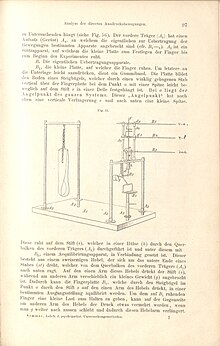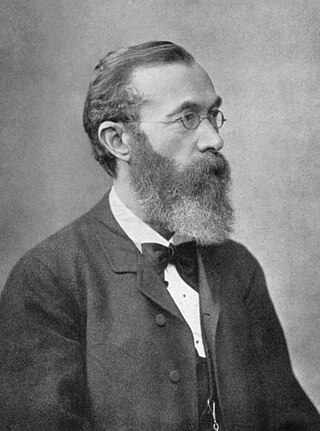
Wilhelm Maximilian Wundt was a German physiologist, philosopher, and professor, known today as one of the fathers of modern psychology. Wundt, who distinguished psychology as a science from philosophy and biology, was the first person ever to call himself a psychologist.
Experimental psychology refers to work done by those who apply experimental methods to psychological study and the underlying processes. Experimental psychologists employ human participants and animal subjects to study a great many topics, including sensation, perception, memory, cognition, learning, motivation, emotion; developmental processes, social psychology, and the neural substrates of all of these.
Psychopathology is the study of abnormal cognition, behaviour, and experiences which differs according to social norms and rests upon a number of constructs that are deemed to be the social norm at any particular era.
Psychology is defined as "the scientific study of behavior and mental processes". Philosophical interest in the human mind and behavior dates back to the ancient civilizations of Egypt, Persia, Greece, China, and India.
Eugène (Eugeniusz) Minkowski was a French psychiatrist of Jewish Polish origin, known for his incorporation of phenomenology into psychopathology and for exploring the notion of "lived time". A student of Eugen Bleuler, he was also associated with the work of Ludwig Binswanger and Henri Ey. He was influenced by phenomenological philosophy and the vitalistic philosophy of Henri Bergson, and by the phenomenologists Edmund Husserl and Max Scheler; therefore his work departed from classical medical and psychological models. He was a prolific author in several languages and regarded, as a great humanitarian. Minkowski accepted the phenomenological essence of schizophrenia as the "trouble générateur", which he thought consists in a loss of "vital contact with reality" and shows itself as autism.
Child psychopathology refers to the scientific study of mental disorders in children and adolescents. Oppositional defiant disorder, attention-deficit hyperactivity disorder, and autism spectrum disorder are examples of psychopathology that are typically first diagnosed during childhood. Mental health providers who work with children and adolescents are informed by research in developmental psychology, clinical child psychology, and family systems. Lists of child and adult mental disorders can be found in the International Statistical Classification of Diseases and Related Health Problems, 10th Edition (ICD-10), published by the World Health Organization (WHO) and in the Diagnostic and Statistical Manual of Mental Disorders, Fifth Edition (DSM-5), published by the American Psychiatric Association (APA). In addition, the Diagnostic Classification of Mental Health and Developmental Disorders of Infancy and Early Childhood is used in assessing mental health and developmental disorders in children up to age five.

Karl Ludwig Kahlbaum was a German psychiatrist.

Otto Selz was a German psychologist from Munich, Bavaria, who formulated the first non-associationist theory of thinking, in 1913. Influenced by the German phenomenological tradition, Selz used the method of introspection, but unlike his predecessors, his theory developed without the use of images and associations. Wilhelm Wundt used the method of introspection in the 1880s, but thought that higher-level mental processes could not be studied in the scientific laboratory.
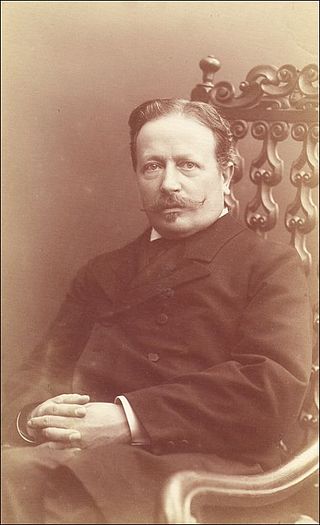
Georg Theodor Ziehen was a German neurologist and psychiatrist born in Frankfurt am Main. He was the son of noted author, Eduard Ziehen (1819–1884).
Jochen Fahrenberg is a German psychologist in the fields of Personality, psychophysiology and philosophy of science.

Erich Schröger is a German psychologist and neuroscientist.

Karl Robert Sommer was a german psychiatrist and genealogist born in Grottkau. He is remembered for his work in experimental psychology. He coined the term „Psychohygiene“ in 1901 and founded the „German Association for Psychohygiene“ and the „Society for Experimental Psychology“. He is remembered for his work in experimental psychology. He also published on genealogy, philosophy, and forensics. He was also an active inventor and involved in local politics.

John Michael Steiner was a Czech-American Sociologist and Holocaust researcher.
Lutz Jäncke is a neuropsychologist and a cognitive neuroscientist.
Hans-Ulrich Wittchen is a clinical psychologist, psychotherapist and epidemiologist. He has been a head of the Institute of Clinical Psychology and Psychotherapy and the Center of Clinical Epidemiology and Longitudinal Studies (CELOS) at the Technische Universität Dresden. Since 2018, he is leading the research group "Clinical Psychology and Psychotherapy Research" at the Psychiatric Clinic of Ludwig-Maximilians-Universität München and directs the IAP-TU Dresden GmbH in Dresden.
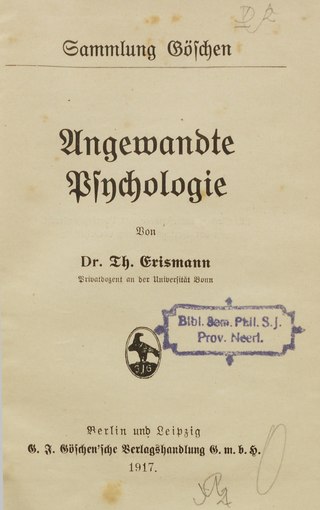
The book "Angewandte Psychologie", by the Swiss-Austrian psychologist and philosopher Theodor Paul Erismann, was published in 1917 in Berlin and Leipzig. It discusses major topics concerning school, work, law and their connections to psychology. The book aims at giving a short overview of how psychology can be applied to important areas in life. Erismann uses many applicable tests and describes them in great detail, thus providing a practical guideline on how to use the findings of psychology in different fields.
Ursula Hess is a German psychologist who teaches at the Humboldt-University of Berlin as Professor of Social and Organizational Psychology at the Department of Psychology.
Georg Ernst Anschütz was a German psychologist, who worked especially in the field of music psychology and synaesthesia. Due to his exposed role during the National Socialism period, he was dismissed from university service after 1945. His writings were nevertheless reprinted until the 1970s.
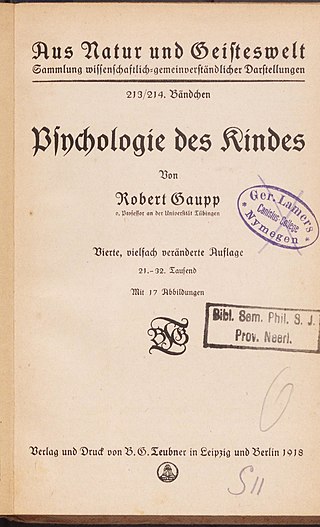
Psychologie des Kindes is a book written by the German psychiatrist and neurologist Robert Gaupp. It was first published in 1907 by the publishing house B.G. Teubner Leipzig Berlin. There were a total of four versions of the book, the last revised version appearing in print in 1917.
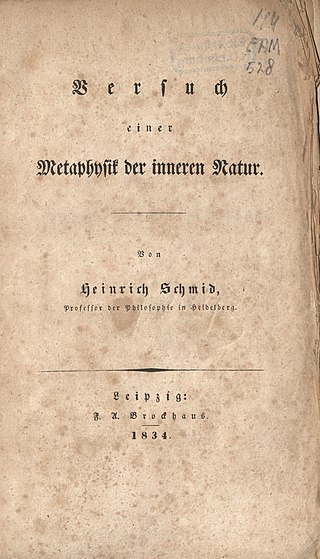
Versuch einer Metaphysik der inneren Natur is a book written by German author Heinrich Schmid (1799–1836). It was published by Brockhaus Leipzig in 1834. In this book, Schmid attempts to develop a metaphysical account of humans' inner nature, the soul, in terms of general laws. These laws, Schmid proposes, should be based on empirically gathered knowledge about inner nature. He argues, that with the formulation of such laws, psychology, the science of the human soul, should become a natural science like physics. Schmid's ideas build heavily on the philosophy of Immanuel Kant, for which he was criticized. He belonged to the philosophical school surrounding Jakob Friedrich Fries, whose ideas are associated with Neo-Kantianism. Schmid's theories, especially concerning memory, were adopted by Sir William Hamilton, whose philosophy was discussed by John Stuart Mill at the end of the 19th century. Wilhelm Wundt and his contemporaries still used methods similar to Schmid's structured introspection once psychology was founded as an independent discipline in 1879.


